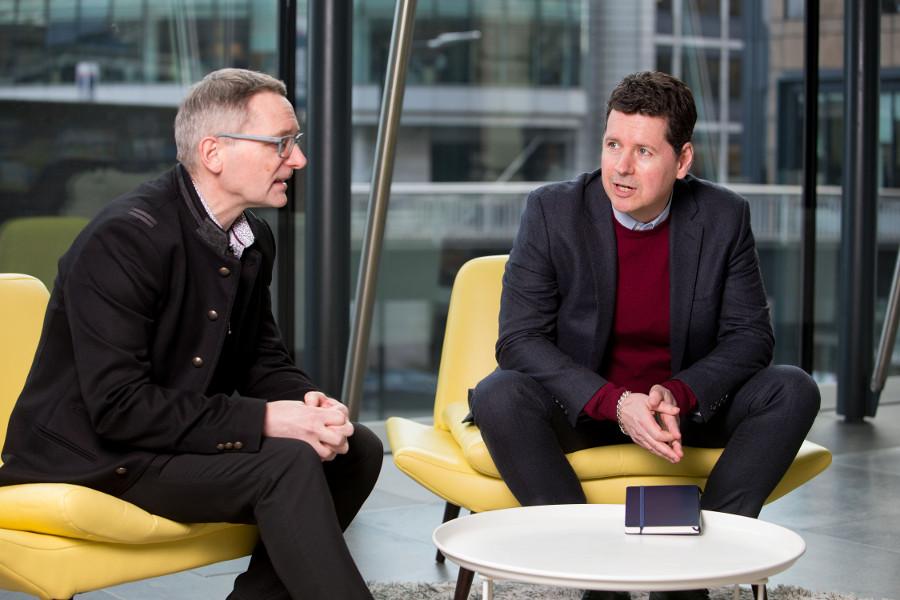
- Support portal
- Evaluation Kits and partner products
u-blox Support
- Product documentation
Documentation
- Investor relations
Investor relations
Stories
|
27 Jul 2018
Where is our brave new connected society headed? We sat down with Greg Williams, Editor-in-Chief of Wired and Paul Gough, Principal, Corporate Strategy of u blox to look into some of the future applications it has the potential to enable.

PAUL GOUGH - People have always been connected, but modern technology has really expanded these connections. Today’s connectivity is the basis on which we've built whole new personal and societal services.
GREG WILLIAMS - I think the big difference today is scale, and the fact that we have these objects in our hands at all times effectively makes us augmented human beings. We have access to the most powerful computing stack ever created, to all the information the world has ever created, and to pretty much anyone who is on the Internet. Then there is all this data that we're creating. If we can make it open and let people share it, it would enable us to make the world, frankly, better – and our businesses more efficient.
P.G. - In the recent past, connectivity technology was focused on getting faster, with more ubiquitous access. We went from 2G to 3G, to 4G. But now we see companies like u-blox starting to bring in a new wave of devices that emphasize really low power and are much smaller and more affordable. We can now think about connecting other objects to the Internet, particularly things like sensors. We're going to see a much more quantified world, in terms of both our immediate environment and our personal spaces.
G.W. – We will get to the point where we can pretty much measure everything through tiny sensors that will tell us about air quality or when the rubbish bin needs emptying. It's a question of determining what's useful.

How do you see the evolution of wearables, which represent a big share of the “connected people” market?
P.G. – Today’s devices are still pretty clunky, bulky, and power hungry. We need another generation of technology to shrink it down another level, make it more power efficient, and bring in other technologies like flexible electronics.
G.W. - We're almost at the fourth iteration of the Apple Watch, and I think that it's only just beginning, now, to become something that has a use case. How do we start building this kind of connectivity into clothing and devices that we wear on our skin? It becomes really interesting when the devices are not just passive, but nudge us into various forms of activity, when they make predictions about health outcomes, or tell us that we need to start behaving in different ways.
P.G. - Today customers want to know the specification of your device, but also what you are doing in terms of security. Security has become a quality issue.
G.W. - This reflects on a bigger point, which is around privacy, where there is a shift going on. I certainly feel that there will be public and regulatory demand for the Silicon Valley companies to be a lot less extractive than they are now and to share more of that data that they do extract. There is more awareness of privacy now, but not enough of security. It’s something that we all need to think about. Not just manufacturers or consumers or governments – it's everyone.
P.G. – I think this new wave of devices and the whole issue of generating data has momentum and will carry on. Like a tide, it cannot be stopped. On the positive side, with this extra data, you can start to see things like early diagnosis, for example, in medical conditions. But if that's going to happen, it comes with responsibilities. But I think Big Data is inevitable.
G.W. - It is inevitable, by the very nature of what we're doing, attaching sensors to everything. However, I think that there's a shift now with consumers wanting more access to their data and to know exactly how it's being used. And also understanding that their data is the product – they are the product. Don't get me wrong. I think there's so much about the Internet that's amazing, in terms of information sharing and learning. But I do think that we now have three or four companies that are effectively the gatekeepers of the Internet. Things need to change a little bit in terms of the amount of access and power they have over consumers.
G.W. - We are getting to the point with AI that our machines and systems are beginning to anticipate our needs in ways they weren't able to even five years ago. We've been talking about AI for some time, but now we are genuinely seeing producing products that will have a significant benefit to us. I think AR will definitely be something that will increasingly become part of our lives, because I can see a use case. I can't see the smartphone going away. It's the best thing that we've created. It’s given rise to a massive supply chain, which is responsible for a lot of what's going on in the world of IoT and connected devices. We'll probably still be carrying smartphones in 10 years.
P.G. - We'll certainly see devices becoming smarter. Radios themselves will have multiradios, handling multiple frequencies and air standards. When they need to send information, they'll do it in the most efficient, low power, or fastest way depending on the context. I think the same will happen with the microprocessors that we work with today, that are based on standard von Neumann architecture. Eventually we'll get neuromorphic processors.
G.W. - I think autonomous vehicles are going to fundamentally transform the nature of our cities, of mobility, of uses of energy. And that may be more powerful than even the smartphone, because it will essentially change our built environments. Although physically we might still recognize our built environment in 15-20 years, they will function in a very different way.
P.G. - AI has come out of the winter. There’s deep learning, we can make it scale, and suddenly AI can do image recognition as well as we can. The car will probably be the vehicle that will drive AI, sensors, and sensor fusion. And your car and your personal assistant in your phone will interact seamlessly with each other. It was people like Elon Musk at Tesla who came along and kicked the industry. When somebody like that comes along and is able to show what the possibilities are if you're bold enough. It’s interesting that the industry has reacted.
Read the entire interview in the Connected People edition of the u-blox magazine
